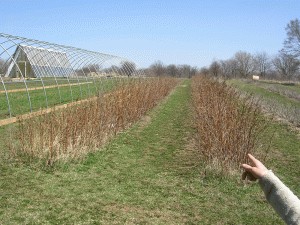When you decide to be a farmer, you have to start somewhere.
How about a row of raspberries?
Last April I drove an hour and a half to East Troy WI for the “Berrylicious Workshop” at the Michael Fields Agricultural Institute , which promised and provided hands-on training in pruning, thinning, fertilizing and propagating of strawberries, raspberries and currants.
The first thing I learned is that raspberries do much better in their favorite soil, and from a raspberry’s perspective, that’s means moist, humus-rich earth that mimics the forest floor. What I had to offer was hard, clay soil that had been farmed conventionally for many years then driven over by heavy equipment during the barn building process (see my post Building Our Timberframe Barn here) – not quite a raspberry’s preferred neighborhood.
We selected the best bit of ground we could find near our barn for a test row, and began to prep the ground with a double manure cocktail: one part horse and two parts green.
I collected the horse manure by walking my Powerwagon (check out my post on this handy tool here) across the road where my neighbor owns and boards horses. She has heaping piles of manure and offered me as much as I can haul. I ended up hauling 3 loads for this project. Nothing I’ve done yet has made me feel so much like a farmer as forking that horse shit in and out of my wagon!
I mixed my brown gold liberally with the several bales of hay and turned it a few times over the months to compost and mellow it.
In the meantime, we added a shiny red rototiller to our farm equipment (Troybuilt Pony Garden Tiller with the more efficient and quieter Honda engin to be precise). Now we were ready to roto!
Yes, we are learning that these things can do damage to soil structure, mess with your mycorrhizal fungi and other living things in the soil while waking up weed seeds. But we feel like it can be used judiciously at the first step of preparing this ground (compacted during the barn building.
From now on the roots of the cover crops will be softening the soil. Plants with fibrous roots work best if you have compaction in the top six inches and for deep compaction (what you get if you drive on wet soil) needs plants with deep tap roots. As the roots decompose, they leave wonderful tunnels which water fills, and over several years of the freeze/thaw cycle, some serious softening is underway. Worms will use the tunnels and add their own compost. Finally fresh roots will like to glide along the pathways left by previous roots. It’s a beautiful system.
Just before July we finally had time to begin. Doug worked up a row three feet wide and 150 feet long that follows the curve of the drive. We incorporated our composted horse manure and planted a crop of buckwheat as green manure, which we plan to cut very soon. Then we will plant a second green manure crop of winter rye into the buckwheat mulch, which in turn will be cut next spring when we plant the raspberries.
Back to the buckwheat because that is where we are right now. I just completed my second class at Michael Fields last week on the pertinent topic of Managing Cover Crops, taught by Dr. Jim Stute, a University of Wisconsin-Extension Crops and Soils Educator. Sitting on a bale of hay in Dr. Stute’s barn, I learned that cover crops are like chain saws. They are a powerful tool that can also cause a lot of damage. (More about this in a future post.)
Buckwheat, Dr. Stute said is a good crop to plant after harvest because it germinates and grows fast. (We weren’t actually planting after a harvest, but it was the same time of year.) He said that when you plant buckwheat in a field, you can look behind you and see it popping out of the ground.
Buckwheat has a primary tap root that may go down 3 or 4 feet with side roots. He praised its above-ground spreading structure which protects soil from wind erosion. But he warned that if we are foolish enough to let it set seed, we will be seeing a lot more than we want to of buckwheat next year.
He was right about how fast it comes up. We sewed the seed by hand and then covered it lightly with clover mulch that we had mowed in the barnyard across the lane. Just a few days later, tender little leaves were popping up all over. Dr. Stute says its 70 days from seed to seed with buckwheat. We have just passed Day 60, so I’m watching closely–and I’m enjoying what I see. Buckwheat makes a beautiful crop with delicate white blossoms crowning the stalks.
Stay tuned for updates. This saga will hopefully culminate with frozen raspberries for breakfast in the winter of 2010. These raspberries will be best savored, I think, on buckwheat-rye pancakes.
Categories: SUSTAINABLE FOOD, TALES FROM OUR 44 ACRES




Hi!
Just in front of me is a patch of buckwheat, my dad planted it sometime this summer. Fairly recently, I think, it looks to be about four or five inches tall. Cover crops kind of scare me. That whole chainsaw thing. All right–a lot about farming scares me. That’s probably why it’s so exciting. being home, where I don’t have MFAI staff holding my hand, makes me realize both how much I absorbed without realizing it and also how much I still have to learn.
But it’s a beautiful day. Good place to start.
Mara from Michael Fields